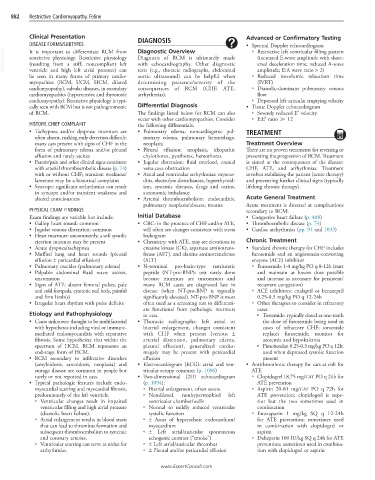Page 1756 - Cote clinical veterinary advisor dogs and cats 4th
P. 1756
882 Restrictive Cardiomyopathy, Feline
Clinical Presentation Advanced or Confirmatory Testing
DISEASE FORMS/SUBTYPES DIAGNOSIS • Spectral Doppler echocardiogram
Diagnostic Overview
VetBooks.ir restrictive physiology. Restrictive physiology Diagnosis of RCM is ultimately made (increased E-wave amplitude with short-
○ Restrictive left ventricular filling pattern
It is important to differentiate RCM from
ened deceleration time; reduced A-wave
(resulting from a stiff, noncompliant left
with echocardiography. Other diagnostic
amplitude; E:A wave ratio > 2)
ventricle and high left atrial pressure) can
aortic ultrasound) can be helpful when
be seen in many forms of primary cardio- tests (e.g., thoracic radiographs, abdominal ○ Reduced isovolumic relaxation time
myopathies (RCM, UCM, HCM, dilated determining presence/severity of the (IVRT)
cardiomyopathy), valvular diseases, in secondary consequences of RCM (CHF, ATE, ○ Diastolic-dominant pulmonary venous
cardiomyopathies (hypertensive and thyrotoxic arrhythmias). flow
cardiomyopathy). Restrictive physiology is typi- ○ Depressed left auricular emptying velocity
cally seen with RCM but is not pathognomonic Differential Diagnosis • Tissue Doppler echocardiogram
of RCM. The findings listed below for RCM can also ○ Severely reduced E′ velocity
occur with other cardiomyopathies. Consider ○ E:E′ ratio ≫ 12
HISTORY, CHIEF COMPLAINT the following differentials:
• Tachypnea and/or dyspnea: murmurs are • Pulmonary edema: noncardiogenic pul- TREATMENT
often absent, making early detection difficult; monary edema, pulmonary hemorrhage,
many cats present with signs of CHF in the neoplasia Treatment Overview
form of pulmonary edema and/or pleural • Pleural effusion: neoplasia, idiopathic There are no proven treatments for reversing or
effusion and rarely ascites chylothorax, pyothorax, hemothorax preventing the progression of RCM. Treatment
• Paresis/pain and other clinical signs consistent • Jugular distension: fluid overload, cranial is aimed at the consequences of the disease:
with arterial thromboembolic disease (p. 74) vena cava obstruction CHF, ATE, and arrhythmias. Treatment
with or without CHF; transient weakness/ • Atrial and ventricular arrhythmias: myocar- involves stabilizing the patient (acute therapy)
lameness may be a historical complaint ditis, electrolyte disturbances, hyperthyroid- and preventing further clinical signs (typically
• Syncope: significant arrhythmias can result ism, systemic diseases, drugs and toxins, lifelong chronic therapy).
in syncope and/or transient weakness and autonomic imbalance
altered consciousness • Arterial thromboembolism: endocarditis, Acute General Treatment
pulmonary neoplasia/abscess, trauma Acute treatment is directed at complications
PHYSICAL EXAM FINDINGS secondary to RCM:
Exam findings are variable but include: Initial Database • Congestive heart failure (p. 408)
• Gallop heart sound: common • CBC: in the presence of CHF and/or ATE, • Thromboembolic disease (p. 74)
• Jugular venous distention: common will often see changes consistent with stress • Cardiac arrhythmias (pp. 94 and 1033)
• Heart murmurs: uncommonly, a soft systolic leukogram
ejection murmur may be present • Chemistry: with ATE, may see elevations in Chronic Treatment
• Acute dyspnea/tachypnea creatine kinase (CK), aspartate aminotrans- • Standard chronic therapy for CHF includes
• Muffled lung and heart sounds (pleural ferase (AST), and alanine aminotransferase furosemide and an angiotensin-converting
effusion ± pericardial effusion) (ALT) enzyme (ACE) inhibitor
• Pulmonary crackles (pulmonary edema) • N-terminal pro-brain-type natriuretic ○ Furosemide 1-4 mg/kg PO q 8-12h (start
• Palpable abdominal fluid wave: ascites, peptide (NT-pro-BNP): test rarely done and maintain at lowest dose possible
uncommon because murmurs are uncommon and and increase as necessary for persistent/
• Signs of ATE: absent femoral pulses, pale many RCM cases are diagnosed late in recurrent congestion)
and cold footpads, cyanotic nail beds, painful disease (when NT-pro-BNP is typically ○ ACE inhibitors: enalapril or benazepril
and firm limb(s) significantly elevated). NT-pro-BNP is most 0.25-0.5 mg/kg PO q 12-24h
• Irregular heart rhythm with pulse deficits often used as a screening test to differenti- ○ Other therapies to consider in refractory
ate functional from pathologic murmurs cases
Etiology and Pathophysiology in cats. ■ Torsemide: typically dosed at one-tenth
• Cause unknown: thought to be multifactorial • Thoracic radiographs: left atrial or the dose of furosemide being used in
with hypotheses including viral or immune- biatrial enlargement, changes consistent cases of refractory CHF; torsemide
mediated endomyocarditis with reparative with CHF when present (venous ± replaces furosemide; monitor for
fibrosis. Some hypothesize that within the arterial distention, pulmonary edema, azotemia and hypokalemia
spectrum of HCM, RCM represents an pleural effusion), generalized cardio- ■ Pimobendan 0.25-0.3 mg/kg PO q 12h;
end-stage form of HCM. megaly may be present with pericardial used when depressed systolic function
• RCM secondary to infiltrative disorders effusion present
(amyloidosis, sarcoidosis, neoplasia) and • Electrocardiogram (ECG): atrial and ven- • Antithrombotic therapy for cats at risk for
storage disease are common in people but tricular ectopy common (p. 1096) ATE
rarely or not reported in cats. • Two-dimensional (2D) echocardiogram ○ Clopidogrel 18.75 mg/CAT PO q 24h for
• Typical pathologic features include endo- (p. 1094): ATE prevention
myocardial scarring and myocardial fibrosis, ○ Biatrial enlargement, often severe ○ Aspirin 20-81 mg/CAT PO q 72h for
predominately of the left ventricle. ○ Nondilated, nonhypertrophied left ATE prevention; clopidogrel is supe-
○ Ventricular changes result in impaired ventricular chamber/walls rior but the two sometimes used in
ventricular filling and high atrial pressure ○ Normal to mildly reduced ventricular combination
(diastolic heart failure). systolic function ○ Enoxaparin 1 mg/kg SQ q 12-24h
○ Atrial enlargement results in blood stasis ○ ± Areas of hyperechoic endocardium/ for ATE prevention; sometimes used
that can lead to thrombus formation and myocardium in combination with clopidogrel or
subsequent thromboembolism to systemic ○ ± Left atrial/auricular spontaneous aspirin
and coronary arteries. echogenic contrast (“smoke”) ○ Dalteparin 100 IU/kg SQ q 24h for ATE
○ Ventricular scarring can serve as nidus for ○ ± Left atrial/auricular thrombus prevention; sometimes used in combina-
arrhythmias. ○ ± Pleural and/or pericardial effusion tion with clopidogrel or aspirin
www.ExpertConsult.com

